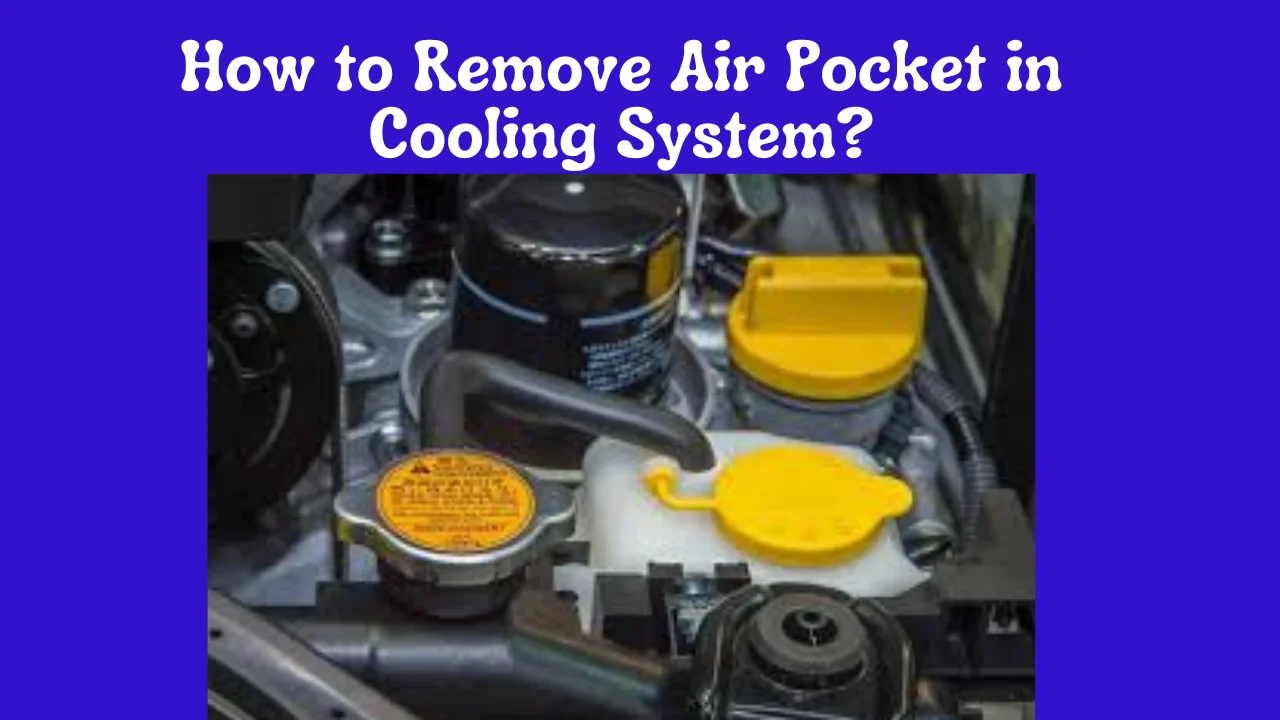Keeping the cooling system in good working order is critical for the durability and efficiency of engines, especially those used in heating and automobiles. In order to avoid engine overheating and maintain optimal performance, this article delves into the specifics of how to remove air pocket in cooling system? The methods presented here are designed to be simple enough for anyone with a basic understanding of mechanics to safely implement on their own.
Understanding Air Pockets in Cooling Systems
The problems that can arise from air pockets in a cooling system are numerous and can range from ineffective cooling to serious engine damage caused by overheating. When air gets stuck in a cooling system, it can displace coolant and create areas with very low heat exchange, which is called an airlock. If this problem is not addressed, it can cause the engine to develop hot spots, which can lead to the failure of engine components due to the high temperatures.
Why Air Pockets Are Problematic
The cooling system is not able to function efficiently due to air pockets. Because air is not a good heat conductor like coolant, engine components might not get as cold as they should. Wear and tear on the engine, elevated operating temperatures, and even engine failure can result from this inefficiency.
Common Causes
While air pockets are most commonly introduced when coolant is refilled, they can also form as a result of coolant leaks or an inadequate bleeding of the cooling system following maintenance. In order to prevent and fix air pockets, it is helpful to understand their causes.
Signs of Air Pockets in the System
To do maintenance on time, you must be able to recognize the symptoms of air pockets. Overheating, fluctuating temperature gauges, and unexpected coolant loss are common symptoms. Another sign that air is trapped in the radiator or hoses is the gurgling sound that some heating systems make.
Preventing Air Pockets
Regularly checking for leaks, properly bleeding the system after adding coolant or performing system maintenance, and keeping the cooling system topped up with coolant are all preventative measures to take. You can greatly lessen the chances of air formation by taking these preventative measures.
Tools Required for Removing Air Pockets
An essential tool for this job is a coolant refill kit, which may include a funnel and bleed key based on the system’s specifications. When you have the correct equipment, bleeding air from the system is easier, faster, and safer.
Step-by-Step Guide to Bleeding Air from Cooling Systems
If you want your cooling system to work properly and safely after removing air pockets, there are a number of important steps to follow in a specific order.
Preparing the Vehicle
Make sure the engine is cool so people don’t get burned. Carefully remove any pressure from the system by opening the radiator cap. To ensure everyone’s safety, this is the very first stage.
Filling the Radiator
To fill the radiator up to the mark, add coolant. Depending on the weather and the type of engine, use a different mixture. In case any air gets purged out of the system, this step makes sure there’s enough coolant to replace it.
Running the Engine
Get the engine going with the heat dialed all the way up. Because of this, the coolant can move around and air can get out of the heater. At this stage, it is critical to keep an eye on the temperature gauge.
Bleeding the System
Find the engine block or radiator where you’ll find the bleed screw. To let air out, open it slightly. When the air-coolant mixture starts to transition into a steady stream, it means the air has been purged.
Checking and Adjusting Coolant Levels
Recheck the engine’s coolant level and add more as needed after it has cooled down. This last stage guarantees that all of the coolant has been added and that there is no air in the system.
Troubleshooting for Persistent Air Pockets
If the air pocket problem persists after you’ve followed the basic procedures for removing air from the cooling system, you may need to resort to more advanced troubleshooting methods. In this section, we will explore more advanced techniques for identifying and fixing cooling system airlock issues.
Stubborn Air Pockets
Traditional methods of bleeding may not be able to remove air pockets that persist. Additional diagnostic procedures may be required to identify these pockets in such instances. If you want to find trapped air in your radiator or hoses, you can use a thermal scanner or an infrared thermometer to find cold spots.
Using a Vacuum Bleeding Tool
Having a vacuum bleeding tool on hand can be really helpful when dealing with stubborn air pockets. This device forcesfully removes air from the cooling system, leaving only coolant, by creating a vacuum inside the system. The sophisticated cooling systems found in today’s automobiles benefit greatly from this approach.
Checking for System Leaks
When air pockets don’t go away, it could be a sign of a more serious problem, like a leak. It is critical to look for leaks in the coolant system by inspecting the water pump, radiator, and all hoses. Because leaking parts can reintroduce air, fixing them is a prerequisite to bleeding the system again.
Long-Term Health of Your Cooling System
To keep your cooling system in top shape for the long haul, it takes more than just letting air out now and then; regular maintenance and inspections are essential for avoiding problems and keeping it running at peak efficiency.
Regular Coolant Changes
The quality of coolant decreases as time and use pass. To keep the coolant effective and prevent corrosion—which can cause air pockets and other cooling system problems—it should be changed regularly according to the manufacturer’s guidelines.
Systems Flush Procedures
Rust, scale, and other contaminants can build up in the cooling system and cause air pockets to form; flushing the system periodically removes these contaminants. A complete flush ensures that the coolant flow pathway remains clean, which improves the system’s efficiency and lifespan.
Monitoring System Pressure
Verifying the pressure in the cooling system on a regular basis can help catch problems before they escalate. In order to avoid air leaks and infiltration, it is important to use a pressure tester to check that the system stays at the pressure that was specified by the manufacturer.
Optimization Techniques for Enhanced Performance
Certain optimization techniques can be used to make the cooling system as efficient and reliable as possible, especially in places or cars that require a lot of power.
Coolant Additives
The coolant’s ability to transfer heat and its resistance to freezing and boiling can be enhanced with the use of high-quality additives. These additives enhance the flow characteristics of the coolant, which in turn helps to decrease the formation of air pockets.
Cooling System Components
An upgrade to a high-performance water pump, hoses, or radiator can improve cooling efficiency and strengthen protection against air pockets and overheating in systems or vehicles that operate in extreme conditions.
System Balancing and Tuning
Preventing overheating and air pockets requires regular system balancing and tuning to ensure all components work harmoniously. To achieve this goal, it may be necessary to check sensor readings, change fan speeds, and adjust the thermostat.
FAQs
Can air pockets damage my engine?
Yes, air pockets can cause hot spots that potentially damage engine components and lead to overheating.
How often should I bleed my cooling system?
It’s wise to bleed the cooling system any time you refill or perform maintenance that involves the coolant.
Is a coolant flush necessary for removing air pockets?
While not always necessary for air removal, a coolant flush can help by clearing blockages and ensuring a clean, air-free system.
Can I use any coolant to refill my system?
Always use the coolant type specified by the manufacturer to avoid chemical incompatibility and potential damage.
What’s the best way to detect a coolant leak?
Look for visible signs of coolant under the vehicle, or use a dye in the coolant that shows up under UV light to identify leaks.
Conclusion
When the air is effectively removed from the cooling system, the engine’s performance and efficiency are improved. To keep the engine running for a longer period of time and avoid expensive repairs, it is essential to do regular maintenance checks, recognize the symptoms of possible problems, know what to do in such situations, and understand How To Remove Air Pocket In Cooling System? Most car owners can do this with the correct information and equipment, which gives them a sense of control and security.

Shannon Reyes is a seasoned writer with a knack for crafting engaging blogs on a variety of service industries, including plumbing, cleansing, moving, pest control, and roofing. With a keen eye for detail and a passion for helping readers navigate complex topics, Shannon brings her expertise to life through informative and accessible content.











Can you be more specific about the content of your article? After reading it, I still have some doubts. Hope you can help me. https://accounts.binance.info/tr/register-person?ref=MST5ZREF